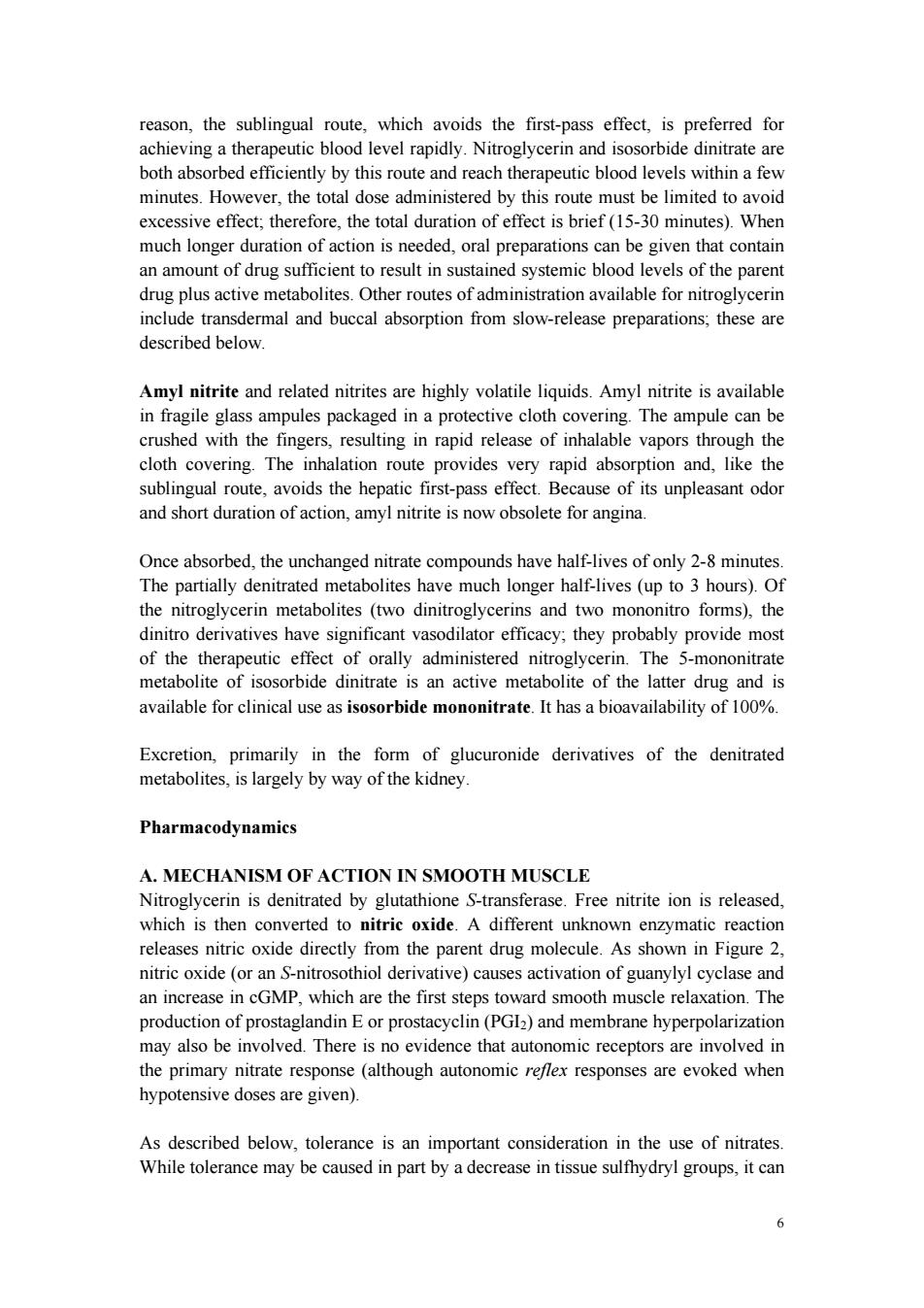正在加载图片...

reason,the sublingual route,which avoids the first-pass effect,is preferred for achieving a therapeutic blood level rapidly.Nitroglycerin and isosorbide dinitrate are both absorbed efficiently by this route and reach therapeutic blood levels within a few minutes.However,the total dose administered by this route must be limited to avoid excessive effect;therefore,the total duration of effect is brief(15-30 minutes).When much longer duration of action is needed,oral preparations can be given that contain an amount of drug sufficient to result in sustained systemic blood levels of the parent drug plus active metabolites.Other routes of administration available for nitroglycerin include transdermal and buccal absorption from slow-release preparations;these are described below. Amyl nitrite and related nitrites are highly volatile liquids.Amyl nitrite is available in fragile glass ampules packaged in a protective cloth covering.The ampule can be crushed with the fingers,resulting in rapid release of inhalable vapors through the cloth covering.The inhalation route provides very rapid absorption and,like the sublingual route,avoids the hepatic first-pass effect.Because of its unpleasant odor and short duration of action,amyl nitrite is now obsolete for angina. Once absorbed,the unchanged nitrate compounds have half-lives of only 2-8 minutes. The partially denitrated metabolites have much longer half-lives(up to 3 hours).Of the nitroglycerin metabolites (two dinitroglycerins and two mononitro forms),the dinitro derivatives have significant vasodilator efficacy;they probably provide most of the therapeutic effect of orally administered nitroglycerin.The 5-mononitrate metabolite of isosorbide dinitrate is an active metabolite of the latter drug and is available for clinical use as isosorbide mononitrate.It has a bioavailability of 100%. Excretion,primarily in the form of glucuronide derivatives of the denitrated metabolites,is largely by way of the kidney. Pharmacodynamics A.MECHANISM OF ACTION IN SMOOTH MUSCLE Nitroglycerin is denitrated by glutathione S-transferase.Free nitrite ion is released, which is then converted to nitric oxide.A different unknown enzymatic reaction releases nitric oxide directly from the parent drug molecule.As shown in Figure 2, nitric oxide (or an S-nitrosothiol derivative)causes activation of guanylyl cyclase and an increase in cGMP,which are the first steps toward smooth muscle relaxation.The production of prostaglandin E or prostacyclin(PGI2)and membrane hyperpolarization may also be involved.There is no evidence that autonomic receptors are involved in the primary nitrate response (although autonomic reflex responses are evoked when hypotensive doses are given). As described below,tolerance is an important consideration in the use of nitrates. While tolerance may be caused in part by a decrease in tissue sulfhydryl groups,it can 66 reason, the sublingual route, which avoids the first-pass effect, is preferred for achieving a therapeutic blood level rapidly. Nitroglycerin and isosorbide dinitrate are both absorbed efficiently by this route and reach therapeutic blood levels within a few minutes. However, the total dose administered by this route must be limited to avoid excessive effect; therefore, the total duration of effect is brief (15-30 minutes). When much longer duration of action is needed, oral preparations can be given that contain an amount of drug sufficient to result in sustained systemic blood levels of the parent drug plus active metabolites. Other routes of administration available for nitroglycerin include transdermal and buccal absorption from slow-release preparations; these are described below. Amyl nitrite and related nitrites are highly volatile liquids. Amyl nitrite is available in fragile glass ampules packaged in a protective cloth covering. The ampule can be crushed with the fingers, resulting in rapid release of inhalable vapors through the cloth covering. The inhalation route provides very rapid absorption and, like the sublingual route, avoids the hepatic first-pass effect. Because of its unpleasant odor and short duration of action, amyl nitrite is now obsolete for angina. Once absorbed, the unchanged nitrate compounds have half-lives of only 2-8 minutes. The partially denitrated metabolites have much longer half-lives (up to 3 hours). Of the nitroglycerin metabolites (two dinitroglycerins and two mononitro forms), the dinitro derivatives have significant vasodilator efficacy; they probably provide most of the therapeutic effect of orally administered nitroglycerin. The 5-mononitrate metabolite of isosorbide dinitrate is an active metabolite of the latter drug and is available for clinical use as isosorbide mononitrate. It has a bioavailability of 100%. Excretion, primarily in the form of glucuronide derivatives of the denitrated metabolites, is largely by way of the kidney. Pharmacodynamics A. MECHANISM OF ACTION IN SMOOTH MUSCLE Nitroglycerin is denitrated by glutathione S-transferase. Free nitrite ion is released, which is then converted to nitric oxide. A different unknown enzymatic reaction releases nitric oxide directly from the parent drug molecule. As shown in Figure 2, nitric oxide (or an S-nitrosothiol derivative) causes activation of guanylyl cyclase and an increase in cGMP, which are the first steps toward smooth muscle relaxation. The production of prostaglandin E or prostacyclin (PGI2) and membrane hyperpolarization may also be involved. There is no evidence that autonomic receptors are involved in the primary nitrate response (although autonomic reflex responses are evoked when hypotensive doses are given). As described below, tolerance is an important consideration in the use of nitrates. While tolerance may be caused in part by a decrease in tissue sulfhydryl groups, it can